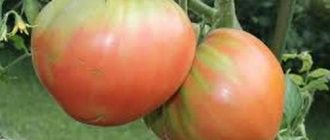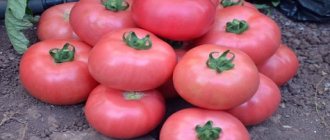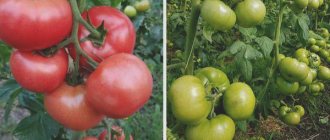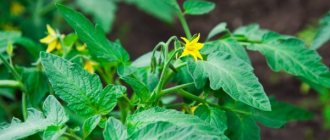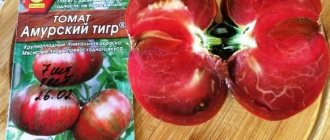Tomato Pink Siberian Tiger is an original hybrid variety from the anthocyanin class. Despite the name, it was created in the USA and has excellent taste and decorative qualities.
| Height | Landing location | Ripening time | Fruit color | Fruit size | Origin | Fruit shape |
| Tall | Greenhouse, Open ground | Mid-season | Bicolor | Average | Hybrid | Flat-round |
Description of Siberian Tiger variety tomatoes
The Siberian Tiger tomato is a large-fruited variety with a striped color. In the southern regions it is suitable for growing in open ground. In the North, planting in greenhouses is recommended.
Tall stems with heavy tomatoes are grown with a garter
The ripening period is average. The leaves are green and large. The bush type is indeterminate, which means unlimited growing season. For such plants, the top of the stem is forcibly pinched a few weeks before the end of the growing season. This allows the growth of the vegetative part to be completed and forces to be directed towards fruit ripening.
For productive cultivation of the crop, several stems are left, other side shoots that appear are promptly removed.
The Siberian Tiger variety is not included in the official sale. Seeds are purchased from foreign companies or from domestic amateur breeders. In the future, the species can be reproduced from its own seeds.
Description of fruits
Tomatoes are round, but can be irregularly shaped or fused. The ribbing is medium. On the lower part of the bush, the fruits grow weighing 300 g, becoming smaller towards the top, on average - 150-200 g.
The pulp of the fruit is sugary, juicy, dense
When unripe, tomatoes are green in color with darker stripes extending from the stem. When ripe, they turn dark red and the stripes turn dark purple. The coloring resembles a tiger's coloring, but is unstable, sometimes the stripes are not clearly visible and the dark color merges into one spot. The streaks are more pronounced when grown in open ground and in intense sunlight.
A special feature of the variety is the sweet taste of the fruit. It contains fruity shades that leave a long and pleasant aftertaste. The characteristic tomato sourness is also not noticeable.
Inside, the tomatoes are multi-celled, the flesh is red with a large number of small seeds. The skin is thin and prone to cracking.
Pest and disease control
If watering rules are violated and the plants receive little light (in greenhouses and greenhouses), the leaves of tomato bushes may be affected by powdery mildew. Also sometimes tomatoes are attacked by pests such as whiteflies and aphids. They can be fought with the help of a special drug “Confidor”.
Instructions for using the solution:
- 1 ml of the product is dissolved in 10 liters of water.
- After preparation, the solution is sprayed onto the seedlings.
Comment! This solution is sufficient to treat a planting area of 100 square meters with tomatoes. m.
Characteristics of the Siberian Tiger tomato
The Siberian Tiger tomato is tall, the bush grows in 2-3 stems. To avoid the growth of stepchildren, they are removed at least once a week, leaving small stumps so that the growth of shoots does not resume. During the growing season, the leaves under the inflorescences are also gradually removed. This ensures good ventilation of the plants.
One bush grows up to seven clusters of 4-6 tomatoes each. Depending on the growing region, the ovaries are rationed so that the remaining fruits have time to ripen. The Siberian Tiger variety is rare, obtained from crossing two different types of tomatoes. It is characterized by unstable characteristics, especially in relation to the shape and color of the fruit.
Siberian Tiger tomato yield and fruiting
The Siberian Tiger variety is classified as medium-yielding. About 2 kg of fruits are harvested from one bush in greenhouse conditions. It begins to bear fruit 3.5 months from the sowing date. The yield is influenced by correct formation, normalization of the amount of ovary, as well as soil fertility and light intensity.
Area of application of fruits
The Siberian Tiger tomato has a salad purpose. Due to their color and longer ripening time, the fruits accumulate many useful substances. The taste is similar to fruit; tomatoes are included in children's diets. Due to their thin skin and large size, tomatoes are not suitable for canning.
Resistance to diseases and pests
The Siberian Tiger tomato has high immunity to diseases. Therefore, it can be cultivated without the use of potent plant protection products. Depending on the growing region and weather conditions, preventive spraying with fungicides is carried out from one to several times a month.
Taste qualities of tomatoes
Tomatoes have excellent taste. The tomatoes are sweetish with a slight sourness. If the plant received little sunlight and heat, or grew in cold weather or rainy periods, the fruit will be more sour.
Tomatoes Tiger Cub are characterized by high yield. From 1 m² you can harvest about 10 kg of tomatoes. Tomatoes tolerate transportation well and are stored well for quite a long period. During the entire storage period of these tomatoes, their wonderful taste and appearance remain unchanged.
Tomatoes can be used fresh, canned, used for making sauces, gravies, and seasonings. They can be fried and boiled, and used to prepare various dishes. Thanks to their original color and excellent taste, these tomatoes look great if they are pickled whole.
The plant is hardy and resistant to various diseases, such as late blight and gray rot.
Advantages and disadvantages of the variety
The Siberian Tiger tomato is an original variety with an exotic color. The crop is also grown for its sweet taste, close to fruity.
The fruits have high vitamin value
pros
- good immunity;
- average ripening time;
- tomatoes are well attached to the stalk.
Minuses
- the crop exhibits instability, the color of the fruit may vary depending on the place of cultivation;
- the variety is not officially registered in Russia, it is not distributed by agricultural companies, so seed material can only be obtained from amateur breeders;
- A tall bush requires increased care, which includes monitoring the growth of stepchildren, gartering and increased feeding rates;
- tomatoes are prone to cracking;
- can be grown in open ground only in the southern regions;
- average yield.
Characteristics of the variety
| Variety type | Variety |
| Bush type | Indeterminate |
| Soil type | Open ground, Film shelters |
| Precocity | Mid-season |
| Color | Brown |
| Fruit weight | 240 g |
| Productivity | 11 kg/sq.m |
| Taste qualities | Fine |
| Application | Salads, Canned food, Whole fruit canning |
| Number of nests | 6 |
The mid-season, medium-fruited variety “Amur Tiger” is relatively new: it was registered in the State Register only in 2015. But it is already widely known among amateur gardeners. Striped tomatoes are valued for their original appearance and excellent taste.
Features of cultivation
The Siberian Tiger tomato is grown using the seedling method. Seedlings are kept indoors for 60-65 days. Sowing is carried out in common or separate planting containers. They can be of plant origin, for example, peat tablets or reusable. Containers that have already been planted in must be disinfected.
Advice! Any container must have drainage holes.
The soil for sowing is fertile and light in composition. It and the seeds are disinfected in a fungicide solution. Sowing is carried out on moist, slightly compacted soil with a short distance. Then mulch with peat or softened coconut substrate.
The seeds germinate in 4-6 days and are immediately moved to a lighted place. The temperature is lowered to +18°C for a week. This stops the growth of the above-ground parts of the plants in favor of the development of the root system. Then the seedlings are grown at a daytime temperature of +22°C, with a desirable decrease of several degrees at night.
Dive the seedlings into separate larger containers when several developed leaves appear
The Siberian Tiger tomato is transferred to a permanent place of cultivation when positive night temperatures are above +10°C and the soil is warmed up. At lower values, plants will not develop, and when the temperature drops, they may die.
Advice! Siberian Tiger tomatoes are grown in open ground or greenhouses at a distance of about half a meter from each other.
The wells are arranged in one or several rows. The depth corresponds to the size of the earthen clod. A large amount of water is poured into the hole before planting. Also, if necessary, add a handful of organic or mineral fertilizer, mix, sprinkle a little soil on top so that there is no direct contact between the roots and the fertilizer.
Plants with a lump of earth are transferred to the resulting substrate, placed vertically and the voids are filled with soil from the ridge. Shade if necessary. The next watering is carried out only 10-12 days after planting. This will allow the root system to go deeper, the plants will be stronger and more productive.
If desired, mulch the soil with cut and dried grass.
Landing
Suitable for growing both under film or in a greenhouse (recommended for the middle zone and Siberia), and in open ground.
Growing seedlings
Seeds are sown 45-50 days before seedlings are planted in the ground (late March - early April). It grows well in the ground without additional fertilizing, but in short daylight conditions it is better to additionally illuminate the sprouts, extending the illumination period to 12-15 hours.
Landing in the ground
It is recommended to maintain a distance between bushes of 40x50 cm, but if there is enough lighting in the selected area, you can plant more often, 30x40 cm. The choice of distance depends on the method of forming the bush. With 2 stems the yield per bush will be less, with 3 stems the yield per square meter will be less. In greenhouses, molding into 3 stems is not used.
How to grow these tomatoes on the plot?
Sowing of seeds is carried out 60-70 days before planting in the garden. The heat-loving crop germinates quickly only when the soil temperature is not lower than +25°C (4-5 days), so you need to germinate the seeds in such conditions. After germination, the temperature can be reduced to +20°C.
They dive at the stage of 2-3 true leaves at a distance of 7-10 cm from each other. The seedlings do not need to be fed, but if there is a lack of natural light on the northern windows, a phytolamp may be needed. The duration of daylight while growing seedlings should be at least 15 hours.
Tomatoes are planted in the garden when the soil warms up to +15°C. In a greenhouse, this can be achieved in early to mid-May, but tomatoes can be planted in open ground no earlier than the first decade of June. 1 week after transplanting, feed the tomatoes with mixtures with a high nitrogen content (nitroammofoska, etc.).
When the first trusses with flowers appear, phosphorus-potassium mixtures are added (superphosphate, potassium nitrate) or ready-made complex fertilizers for tomatoes are used (“Tomato Crystal”, “Signor Tomato”, “Agricola” and others).
This feeding is repeated after 14-15 days. During the filling and ripening of fruits, organic or nitrogen fertilizers cannot be applied: this provokes the growth of green mass to the detriment of fruit formation, and harmful nitrates accumulate in the latter.
Tomato Heavyweight of Siberia - description
The variety is early, the first fruits are ready for consumption 3 months after germination. This is one of the fastest ripening varieties among beef tomatoes.
Characteristics of the bush
The height of the plant is 40-50 cm, in protected soil the stem can stretch up to 80 cm. Tomato stems are strong, but they are not able to support the weight of the fruit, so a garter to a support is necessary.
The foliage of the bush is average. The leaves are light green, small in size, slightly pubescent.
Fruits and yield
Each plant produces 2-3 clusters of fruit. Tomatoes are heart-shaped or bast-shaped, with a dense pink-raspberry shell. The inside of the fruit is multi-chambered, with a high pulp content and a small amount of juice. The taste is sweet, rich.
The average weight of the fruit is 200-280 g, the first tomatoes on the bunch reach a weight of 450 g. If no more than 3-5 fruits are left on the bush, the weight of each can be 700-800 g.
The total yield of the plant is 2.5-3 kg.
Immunity to disease
The heavyweight of Siberia has innate immunity to fusarium and TMV. It does not suffer from temperature changes and tolerates high air humidity.
Reviews from gardeners about tomatoes
The variety is one of the most popular among striped tomatoes. This is confirmed by numerous reviews from vegetable growers left on thematic forums and websites.
Victor, Krasnoyarsk region:
“I liked the Amur tiger for its beautiful stripes, as well as good reviews. Having decided to experiment, I didn’t particularly hope for a good result, but I was pleasantly surprised. The tomatoes were truly colorful on the outside and firm and tender on the inside. But I didn’t prune the bushes in time, so they grew more than 2 m and later began to bear fruit. It was not possible to obtain high-quality seeds from the harvest; every year you need to buy them again. But overall I was pleased with the variety.”
Anna, Sverdlovsk region:
“We have been growing the striped variety in the greenhouse for several years. Despite the not very abundant harvest, tomatoes delight with their beautiful appearance and good taste. I use the Amur Tiger only for salads or cold appetizers; it also produces thick juice and rich sauces. Growing tomatoes is not difficult, the main thing is to plant them in time and not skimp on fertilizers.”
Oksana, Tolyatti:
“I was impressed with the Amur Tiger variety of tomatoes with a good harvest, all the tomatoes are the same size and look good. The seeds sprouted early and quite densely. The taste of the fruit is pleasant, there is little liquid in the pulp, and there are fewer seeds than usual.”
Amur Tiger tomatoes are worth planting for all lovers of exotic vegetables. Tomatoes look good in salads and are also suitable for any type of preservation. Caring for bushes is quite simple and does not require special skills.
Features of caring for the variety
To obtain a high yield, Amur Tiger tomatoes need high-quality fertile soil. The turf soil is fertilized in advance with rotten compost, mullein and mineral additives.
During the growth period, nitrogen compounds are added, and after flowering begins, superphosphate, potassium nitrate or complex fertilizers are added. The vegetable garden, greenhouse and garden tools should also be disinfected before planting, which will help avoid fungal infections.
Knock on wood, or Furniture Manufacturing Business || We are looking for premises
Proper care also includes observing the norms and watering regime. The water temperature should not be lower than +25°C. The procedure is carried out carefully to avoid the formation of a crust on the surface of the earth. Therefore, watering should be combined with weeding and loosening the soil.
Moisture on the leaves should be avoided, as this negatively affects the health of the tomatoes. Waterlogging of the soil during fruit growing leads to the appearance of acid in the taste of tomatoes.
Amur Tiger bushes need to be formed throughout the entire growing season. After flowering, you need to pinch out the growing points and the top of the main stem.
Stepchildren in the lateral axils need to be cut off as they appear, so that the energy of the crop goes to fruiting, and not to thickening the plants.
Tall tomato bushes need to be tied to a support to relieve the load on the stem.
In some cases, the flowers of the variety are susceptible to doubleness, which leads to the formation of irregularly shaped tomatoes. Despite their large size, the fruits look unappetizing. Therefore, it is better to remove large flowers of a changed appearance immediately after detection.
